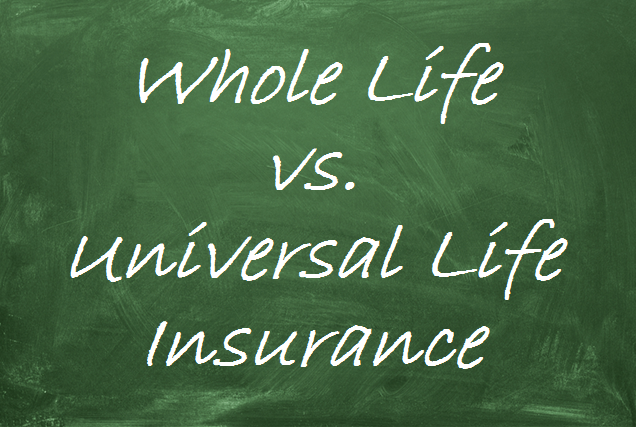
Whole Life Vs. Indexed Universal Life: What Insurance Agents and Financial Advisors Really Think
“Believe (me), it’s not fun trying to explain to a client why his cash value went down and what are those high fees about.”
– Agent/Advisor discussing Whole Life vs. Indexed Universal Life with a colleague
Have you ever wondered if a financial professional was selling you what is really best for you? Perhaps we all have at one time or another. In this post, we peel back the advice that agents and advisors give, not just to their clients, but to their colleagues about permanent life insurance, namely, whole life vs. universal life.
Whole life insurance has been around since before the depression, and has helped policy owners through good times and bad like an old reliable workhorse. In more recent decades, however, some consumers have demanded policies that might resemble a show horse more than a trusty mare. The result has been Universal Life, which has promised – if not always delivered – greater flexibility and faster growth of cash value. (See last week’s post for more about the differences betweenUniversal Life and Whole Life.)
The Debate: Indexed Universal Life vs. Whole Life Insurance
It’s the age-old Tortoise vs. the Hare story. Policyholders have been questioning for decades if they should choose slow-but-steady growth of Whole Life or roll the dice for the chance of faster gains. But consumers haven’t been the only ones asking questions. Financial advisors, insurance agents, even Infinite Banking Practitioners have had questions of their own:
- Which policies should we sell?
- Can we trust the “best case scenario” policy illustrations of Indexed Universal Life?
- How will our clients be affected long-term by one choice or the other?
- Is Indexed Universal Life or Whole Life a better for Infinite Banking strategies?
Recently, we had the chance to eavesdrop on a group of agents and advisors practicingInfinite Banking and other Prosperity Economics strategies. One proposed the question – whole life or indexed universal life? A lively discussion followed in a private LinkedIn group administrated by Kim D. H. Butler. Below is the discussion thread (edited slightly for length and spelling, emphasis mine, with clarifications in brackets[ ], names have been removed for reasons of confidentiality.)
If you have ever sat in front of a financial professional and wondered if there’s a difference between what they’re telling YOU and what they really think, this is for you!
The Question: Pure Whole Life Insurance or Indexed Universal Life?
As posed by Agent #1:
“Recently, I have been challenged by people that have been in this business a lot longer than I. I ran an illustration that is pretty darn impressive for someone to use in their IBC [Infinite Banking Concept]…until I saw an IUL [Indexed Universal Life] illustration that they ran. The “Indexed” part of the IUL allows the policy to… grow cash faster….
At retirement time when one starts taking “loans” from the WL [whole life] policy, you are not overfunding it anymore so the growth slows and even stops and goes backwards whereas in the IUL policy the growth at this point blows the WL policy away. All you smart people already know where I am heading with this…Pure Whole Life Insurance or Indexed Universal Life Insurance for Infinite Banking Concept?”
The Responses: (or, What Insurance Agents and Financial Advisors Really Think about Universal Life)
Agent #2’s response:
Upon seeing for the first time the awkward illustration from EF Hutton sitting on a policyholders desk, I thought it could have been left behind by an alien. And that name.…Universal Life.…or, as it was known in PA, Flexible Premium Adjustable Life.…what was that? Damn, I wanted one. A peek behind the curtain.…to see the Wizard.…computing and illustrating numbers that just crushed the competition: Low cost of insurance.…it was the early Eighties you know.…new money rates at 12% or higher.…make changes as you need or want.…more premium.…less premium.…lower the death benefit when needed.…damn.…I really wanted one…who wouldn’t want this magnificent specimen?
Well, after check writing schemes, interest free loans, money laundering and a host of other misdeeds, EF Hutton is long gone, so too that first generation of UL policies are gone…and probably the 2nd, 3rd, 4th etc generations are all gone. And, they didn’t die because they didn’t illustrate well.….they died because they were bad! That product, that idea, was responsible for more replacements of solid, well funded whole life policies than any one thing that I can recall.
We as an industry let the “stock brokers” and Wall Street dictate what we had to have and sell to our clients. The problem, then as now, is that they can’t deliver.
Agent #3’s response:
IUL does come with extra risks for the policy owners — marketing sound bites notwithstanding… the IUL carriers utilize complicated and unproven hedging strategies to address this extra risk, much of which lies with the IUL policy owners. In this regard, take a look at the “guaranteed” columns in the IUL illustrations. And read the fine print as to index caps — the IUL products that I have seen come with very low cap guarantees, some even guarantee that the cap will be no less than 0.
The situation with IUL resembles the mortgage backed securities debacle of a few years ago.Or as Yogi Berra once said, “It sounds like Deja Vu all over again”.
Agent #4’s response:
If you can read the small print where if you USE the cash value, most if not ALL the guarantees are null and void, you might as well borrow from your 401k, and hope the money will be there when you need it most. Remember, the BEST INVESTMENT is the one that pays you WHEN YOU WANT IT. Imagine telling your client that wants to borrow money against their policy only to learn the money is not there… oops! Do you want to have that conversation with them?
The guarantees are on the death benefit, but should the company have illustrated higher guarantees than they can produce (as they did notoriously with VULS) all they have to do is change the Mortality Charge (the cost of insurance). What kind of guarantee is that?Reminds me of the old adage “I’ll pay your price… if you will meet my terms.
Agent #5’s response:
IUL’s have many issues. Most of which are never discussed by agents selling them. Over-Illustrating rates of returns greater than the general account earnings of the carrier. Using derivatives/options to insure these spreads from 3rd party insurers. Premiums that are increasing in costs each year and become very expensive in retirement years for the client.
These products have a very short history and no proven track record of every coming close to their illustrations. Just because you can illustrate a 6 – 8% return doesn’t mean it will happen. In fact, over the last 10 years IUL’s have performed close to fixed rates products. Run an illustration at 4% on an IUL and whole life with max [cash contributions in form of paid-up additions] and then compare. Look at both the guaranteed and non-guaranteed. Whole life has much more certainty and destroys IUL on the guaranteed side. With IUL’s the cash value usually gets completely depleted and the death benefit goes away on the guaranteed side. The cost of the insurance is too great for the 3% guarantee.
Whole life is the only product I would recommend when implementing a banking policy. Using IUL’s for banking becomes very problematic when illustrating realistic ROR and when the client reaches retirement and the cost of the insurance continues to skyrocket each year, putting stress on the cash value to be used for banking.
Agent #6’s response:
Here’s the problem, and this coming from someone, me, who has written some pretty decent IUL cases in the past and now am only going to use WL… IUL illustrations are based on the illustrated interest rate never changing. It’s suppose to show an average, but you can’t count on that any longer. The stock market is way different now than ever before. Many of the caps in the policies have come down over the years to below 10%. Because of the higher cost in the policies, your average returns with those low caps will not beat WL. If you get zero return that year, your cash value will go down. You don’t want cash value going down in retirement when you’re drawing cash… I know it’s great to say to a client they can never lose money due to market performance, because the CV [cash value] isn’t in the market. However, they can lose cash value due to costs.
WL just goes up each year guaranteed and PUA [paid-up addition] riders give you future cash value increases with NO cost. You don’t want to borrow from a policy with no guarantees of growth…. If you don’t earn enough interest to cover the borrowing cost, especially in years you don’t receive a return or maybe two or three percent, I can’t see where those cost are recovered.
WL will be your best option in my opinion. Believe (me), it’s not fun trying to explain to a client why his cash value went down and what are those high fees about. This happens in years when the market is flat or your interest credited was low. Stick with WL and you won’t go wrong…. And you can sleep better.
The Conclusion: Whole Life or Indexed Universal Life?
Have consumers been led astray? In many cases, we believe so. With IUL’s insurance portion based on renewable term life insurance with rising costs, choosing UL can be a high-stakes gamble. When profits don’t materialize as expected, climbing premiums can make the policy more expensive than it is worth…. literally.
We recommend Whole Life insurance (with a paid-up additions rider to maximize cash value) for clients who desire permanent insurance and/or wish to utilize infinite banking or income-for-life financial strategies. To discuss your situation or obtain a quote on a whole life policy,contact us to schedule a brief consultation.
Popular posts



